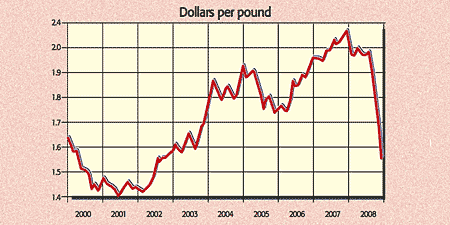
A currency is widely deemed a “national virility symbol”, says Gary Duncan in The Times – and “Britain’s economic potency is fading fast”. The pound has hit a 13-year low against a basket of major trading partners’ currencies and a six-and-a-half-year trough of under $1.48 to the greenback following a 15% slump over the past month and a 25% drop this year. In the same period it has fallen by 33% against the yen and 15% against the euro. Last week it slid by 5.3% against the single currency to another record low of £0.86, its worst weekly performance since the euro’s inception in 1999.
And the pound “remains the winner of the global foreign exchange ugly contest”, as Jeremy Stretch of Rabobank puts it. Britain is sliding into its first recession in 16 years, with the IMF recently warning that it faces the nastiest recession in the Western world, and as grim data have piled up, the Bank of England has signalled further sharp rate cuts. British rates are already below the eurozone’s for the first time since 1999.
The result is a “double whammy” for sterling, says Duncan. Lousy prospects for the economy make British assets unappealing and low rates reduce their relative yield. So the downward pressure on the currency is likely to last. By the end of the year, the pound could be at $1.40 and 88p to the euro, reckons Lee Hardman of Bank of Tokyo Mitsubishi. JP Morgan has pencilled in $1.28 and 92p to the euro by early 2009.
Could the decline in the pound turn into a full-blown collapse if Britain now borrows even more to fuel the economy, as Shadow Chancellor George Osborne warned last weekend? “The more you borrow as a government”, the more debt you have to sell and the less appealing your currency becomes, he notes.
It’s “absurd” to criticise him for “talking down the pound”, says the FT, as he is quite right. Unless the Government comes up with a credible plan to reduce spending in the medium term, international creditors could lose faith in our ability to manage the economy sustainably. Note that ever since Brown has started talking about “fiscal rescues”, sterling has slid, says Liam Halligan in The Sunday Telegraph. A strict reading of our debt to GDP ratio suggests it is over 100% and this year borrowing could reach £100bn, compared to the official estimate of £43bn.
The danger is that investors will stop buying Government debt and there is a run on the pound as confidence collapses, feeding on itself as the falling currency makes investors even more reluctant to hold sterling assets. A sharp slide in sterling implies higher long-term interest rates as bonds are sold off, raising the cost of borrowing for the Government and implying even steeper tax rises later; a plunging currency also threatens to stoke inflation over the medium term.
There’s another element to sterling’s vulnerability, as Hugo Dixon and Edward Hadas point out on Breakingviews. “The UK has an air of Iceland about it.” Foreign investors stopped believing the Government could shore up a banking system with huge foreign currency debts. When investors refused to fund the banks they went under and the currency plunged.
Note that British banks’ foreign currency liabilities were worth almost three times GDP in June (in Iceland the figure was seven times) and exceeded assets by $381bn. A further fall in the pound will increase the sterling cost of these debts and potentially undermine balance sheets. And the Government may not be able to guarantee this debt as it has a mere $38bn of foreign currency reserves. There’s no cash for it to draw on at home because the private sector isn’t earning net foreign currency through trade: the trade deficit is 3% (compared with Iceland’s double figures). All this could “easily end in tears”.
The big picture: huge potential for global car makers
A major problem for the American motor industry is that America’s car market is now saturated, partly because car makers juiced up sales over the past few years by lending customers money at 0%. In emerging markets, conversely, there is still huge potential for global car makers. Only three years ago, America bought ten million more cars than Brazil, India, Russia and China (Brics) combined. This year, total sales in the Bric nations should surpass US levels, says The Economist. In the next 40 years, the number of cars worldwide is expected to more than quadruple to three billion.